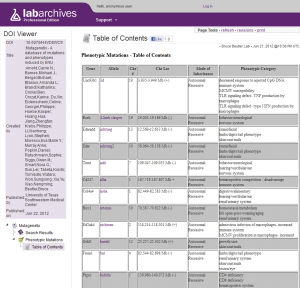N-ethyl-N-nitrosourea (ENU) is a highly mutagenic chemical used in the laboratory for inducing changes in DNA and allowing study of the impact of that change. A team of researchers from the Department of Genetics at The Scripps Research Institute and Southwestern Medical Center’s Center for Genetics of Host Defense, have published a data note in BMC Research Notes, providing the data from over a decade of work to identify 185 phenotypes tracked to ENU induced mutations in 129 genes. Working on the project was Professor Bruce Beutler, winner of the Nobel Prize in Physiology or Medicine in 2011, who says of the work: “Over a period of eleven years we accumulated hundreds of mutations, induced in the mouse genome using the germ line mutagen ENU. Some of these mutations caused striking phenotypes, and broke new ground in immunology, metabolism, neuroscience, and basic cell biology. In effect, we created many new genetic disease in mice, most of which are also represented in humans. Other mutations were not known to cause phenotypes, and were identified ‘incidentally.'”

The teams studied the changes that occurred in mice with ENU induced mutations, storing the data in Mutagenetix, an online database designed for sharing data, and in a LabArchives notebook – an online tool for sharing all information from a given study. As it is analysed further, this data, which has already shown that 21.3% of ENU-induced missense mutations cause phenotypes, will allow for a more in-depth understanding of the effects and actions of these mutations, particularly when predicting whether a given mutation is likely to cause a phenotye. 
Published alongside the ENU mutation data and data note is a commentary from Dr Teresa M Gunn, who explains the importance of the ENU mutation study, and the fact that the data has been made publicly available. Dr Gunn notes “One of the most valuable aspects of this work is that the data presented in this article have been made available using LabArchives, the laboratory notebook software, under a Creative Commons CC0 waiver.” This makes the data freely available to any researcher for reuse, allowing future work to build on these already extensive findings.
This is a powerful example of how collaborations between journals and and science software can make the process of doing science and communicating science more connected and efficient. Also, the data are published in a citable fashion through the assignment of a Digital Object Identifier (DOI) to the dataset by LabArchives, a cause championed by BioMed Central and by BMC Research Notes in particular. Earlier this year, BioMed Central announced a collaboration with LabArchives whereby authors of articles published with BioMed Central journals can receive additional notebook space when signing up for LabArchives’ free service. We hope this will encourage further publication of open data and, in highlighting important data notes such as this from Beutler co-authors, to emphasise how easy it is to make this data ever more visible and accessible.
BioMed Central is keen to develop new ways of making data sharing and reuse easier. We are currently seeking opinions on a proposal to introduce a Creative Commons CC0 waiver for data published in our open access journals. You can join the conversation on our blog site.
Comments